A Scientometric Analysis of Predicting Methods for Identifying the Environmental Risks Caused by Landslides
Abstract
:1. Introduction
Research Significance
2. Methodology
3. Scientometric Analysis Results and Discussion
3.1. Annual Publications and Subject Area of Articles
3.2. Mapping of Keywords
3.3. Mapping Co-Authorship
3.4. Mapping of Countries
4. Different Landslide Prediction Methods
4.1. Physically Based Models
4.2. Probabilistic Models for Landslides
4.3. Landslide Monitoring Methods
5. Case Study of Landslide Prone Regions
5.1. India
5.2. Italy
5.3. China
5.4. United States of America
6. Discussion
7. Conclusions and Future Recommendations
- A scientometric study of data from the database of Scopus showed that the top three disciplines in counting documents were geology, engineering and environmental research ecology, and meteorology and atmospheric science, accounting for 19%, 18%, and 17% of total papers, respectively. There was a slight increase in the number of articles regarding landslides between 2000 and 2010. Furthermore, statistics gathered between 2014 and 2022 indicated a significant increase in publications. The top four most often appearing words were landslides, rainfall, slope stability, and soils. Furthermore, China, Italy, and Japan contributed the most articles on the subject of rainfall-induced landslides. Guzzetti F. was the most cited author, with 1652 citations.
- Physical models of landslides are used to simulate the process of landslide occurrence in physically based landslide susceptibility assessment techniques. A disadvantage of utilizing a physical model is that good mechanical and hydrological soil characteristic data from natural areas is not always available. In physical models, grid cells are used for analysis which have lower resolution. In the probabilistic approach, if the data covers a long-time span in order to cover a present period, the outcomes are meaningful. The disadvantage of using probabilistic methods is their inventory approach, as it is not workable for multi-temporal landslides. Remote sensing is extremely useful for exploring changes in the surface. If the detection can be repeated with sufficient frequency, the RS technique may be utilized as a monitoring tool. Remote rainfall observations can be used to anticipate rainfall-induced landslides.
- There is a need for further study in the Jammu and Kashmir Himalayas and the northeastern zone. The focus has been on states and territories including Uttarakhand, Darjeeling, and parts of Himachal Pradesh. Computational techniques have been shown to be superior to conventional methods in modeling. To understand the region’s heterogeneity and unpredictability, regional- to site-specific analysis using hybrid models and big data analytics can be conducted. Rainfall-induced shallow landslides have hit the Italian and Mediterranean hilly regions of Liguria hard; a semi-quantitative method combining predisposing factors and unstructured data was used for landslide prediction in this area. In China and the USA, river water quality, caused by shallow landslides, can be estimated by the portion of the landslide area at the catchment level, which is more flexible than the local structure of a single landslide and a located near flow.
- Future research directions that need to be explored are as follows:
- ➢
- More research is required to establish if areas with high relief and steep terrain, but no recorded landslides, need additional landslide inventory mapping.
- ➢
- Work should be performed to combine remote sensing data, numerical models, and other landslide-related variables. More detailed remote sensing images should be used for landslide monitoring, risk assessment and hazards assessment.
- ➢
- A publicly available approach will encourage continuing contributions to enhance landslide characterization and awareness across nations.
- ➢
- The resultant map of landslide-prone regions has many drawbacks, including a lower degree of precision when compared to a traditional susceptibility map, and insufficient information regarding instability mechanisms which can be improved.
- ➢
- Natural materials, which make up most slopes, that have inherent variability that is difficult to forecast can be considered for further study.
- ➢
- The physical models are usually limited to a certain type of landslide and they may not be able to accurately describe local geological, soil, and hydrological characteristics that are difficult to see in the field and parameterize in model theory; this issue needs to be addressed in the future.
- ➢
- Landslide danger cannot be fully assessed without more information on slope mechanisms, so these require to be studied.
- ➢
- In order to make landslide inventory layouts for areas where they do not already exist, we suggest testing ways to use the results of susceptibility models made in one area to help people in other areas. This will involve uniformity of the information about landslides and the variables that explain why they happened.
- ➢
- It is suggested that more time is devoted to developing new and much more reliable ways to measure model quality, which should make models more credible and useful.
- ➢
- Work is needed to identify test methods and techniques for the best way to combine zones of land that have the potential for various types of landslides.
Author Contributions
Funding
Institutional Review Board Statement
Informed Consent Statement
Data Availability Statement
Conflicts of Interest
References
- Lucieer, A.; Jong, S.M.D.; Turner, D. Mapping landslide displacements using Structure from Motion (SfM) and image correlation of multi-temporal UAV photography. Prog. Phys. Geogr. 2014, 38, 97–116. [Google Scholar] [CrossRef]
- Ali, A.; Huang, J.; Lyamin, A.V.; Sloan, S.W.; Griffiths, D.V.; Cassidy, M.J.; Li, J.H. Simplified quantitative risk assessment of rainfall-induced landslides modelled by infinite slopes. Eng. Geol. 2014, 179, 102–116. [Google Scholar] [CrossRef]
- Zhu, A.X.; Miao, Y.; Yang, L.; Bai, S.; Liu, J.; Hong, H. Comparison of the presence-only method and presence-absence method in landslide susceptibility mapping. Catena 2018, 171, 222–233. [Google Scholar] [CrossRef]
- Li, T.; He, B.; Chen, Z.; Zhang, Y.; Liang, C.; Wang, R. Effects of gravel on infiltration, runoff, and sediment yield in landslide deposit slope in Wenchuan earthquake area, China. Environ. Sci. Pollut. Res. 2016, 23, 12075–12084. [Google Scholar] [CrossRef]
- Petley, D. Global patterns of loss of life from landslides. Geology 2012, 40, 927–930. [Google Scholar] [CrossRef]
- Westoby, M.J.; Brasington, J.; Glasser, N.F.; Hambrey, M.J.; Reynolds, J.M. Structure-from-Motion’ photogrammetry: A low-cost, effective tool for geoscience applications. Geomorphology 2012, 179, 300–314. [Google Scholar] [CrossRef] [Green Version]
- Shu, H.; Ma, J.; Guo, J.; Qi, S.; Guo, Z.; Zhang, P. Effects of rainfall on surface environment and morphological characteristics in the Loess Plateau. Environ. Sci. Pollut. Res. 2020, 27, 37455–37467. [Google Scholar] [CrossRef]
- Chae, B.-G.; Park, H.J.; Catani, F.; Simoni, A.; Berti, M. Landslide prediction, monitoring and early warning: A concise review of state-of-the-art. Geosci. J. 2017, 21, 1033–1070. [Google Scholar] [CrossRef]
- Zhang, H.; Huang, C.; Hu, X.; Mei, H.; Hu, R. Evaluating water resource carrying capacity using the deep learning method: A case study of Yunnan, Southwest China. Environ. Sci. Pollut. Res. 2022, 1–15. [Google Scholar] [CrossRef]
- Yoshihara, N.; Matsumoto, S.; Umezawa, R.; Machida, I. Catchment-scale impacts of shallow landslides on stream water chemistry. Sci. Total Environ. 2022, 825, 153970. [Google Scholar] [CrossRef]
- Geertsema, M.; Highland, L.; Vaugeouis, L. Environmental impact of landslides. In Landslides–Disaster Risk Reduction; Springer: Berlin/Heidelberg, Germany, 2009; pp. 589–607. [Google Scholar]
- Galve, J.P.; Cevasco, A.; Brandolini, P.; Soldati, M. Assessment of shallow landslide risk mitigation measures based on land use planning through probabilistic modelling. Landslides 2015, 12, 101–114. [Google Scholar] [CrossRef] [Green Version]
- Banerjee, A.; Dimri, A. Comparative analysis of two rainfall retrieval algorithms during extreme rainfall event: A case study on cloudburst, 2010 over Ladakh (Leh), Jammu and Kashmir. Nat. Hazards 2019, 97, 1357–1374. [Google Scholar] [CrossRef]
- Kanungo, D.; Arora, M.K.; Sarkar, S.; Gupta, R.P. A comparative study of conventional, ANN black box, fuzzy and combined neural and fuzzy weighting procedures for landslide susceptibility zonation in Darjeeling Himalayas. Eng. Geol. 2006, 85, 347–366. [Google Scholar] [CrossRef]
- Kanungo, D.; Sarkar, S.; Sharma, S. Combining neural network with fuzzy, certainty factor and likelihood ratio concepts for spatial prediction of landslides. Nat. Hazards 2011, 59, 1491. [Google Scholar] [CrossRef]
- Tofani, V.; Bicocchi, G.; Rossi, G.; Segoni, S.; D’Ambrosio, M.; Casagli, N.; Catani, F. Soil characterization for shallow landslides modeling: A case study in the Northern Apennines (Central Italy). Landslides 2017, 14, 755–770. [Google Scholar] [CrossRef] [Green Version]
- Nsengiyumva, J.B.; Nahayo, L.; Huang, X.; Cai, P. Landslide susceptibility assessment using spatial multi-criteria evaluation model in Rwanda. Int. J. Environ. Res. Public Health 2018, 15, 243. [Google Scholar] [CrossRef] [Green Version]
- Chen, W.; Pourghasemi, H.R.; Kornejady, A.; Xie, X. GIS-based landslide susceptibility evaluation using certainty factor and index of entropy ensembled with alternating decision tree models. In Natural Hazards GIS-Based Spatial Modeling Using Data Mining Techniques; Springer: Berlin/Heidelberg, Germany, 2019; pp. 225–251. [Google Scholar]
- Wu, Y.; Tian, A.; Lan, H. Comparisons of Dynamic Landslide Models on GIS Platforms. Appl. Sci. 2022, 12, 3093. [Google Scholar] [CrossRef]
- Tekin, S.; Çan, T. Slide type landslide susceptibility assessment of the Büyük Menderes watershed using artificial neural network method. Environ. Sci. Pollut. Res. 2022, 1–15. [Google Scholar] [CrossRef]
- Li, K.; Zhao, X.; Xiao, D. Acid rain: An unsuspected factor predisposing Panzhihua airport landslide, China. Environ. Sci. Pollut. Res. 2021, 28, 36753–36764. [Google Scholar] [CrossRef]
- Alvioli, M.; Guzzetti, F.; Rossi, M. Scaling properties of rainfall induced landslides predicted by a physically based model. Geomorphology 2014, 213, 38–47. [Google Scholar] [CrossRef] [Green Version]
- Nikolopoulos, E.I.; Crema, S.; Marchi, L.; Marra, F.; Guzzetti, F.; Borga, M. Impact of uncertainty in rainfall estimation on the identification of rainfall thresholds for debris flow occurrence. Geomorphology 2014, 221, 286–297. [Google Scholar] [CrossRef]
- Endo, T. Probable Distribution of the Amount of Rainfall Causing Landslides. 1970. Available online: https://agris.fao.org/agris-search/search.do?recordID=US201300555779 (accessed on 29 March 2022).
- Guo, X.; Cui, P.; Li, Y.; Zou, Q.; Kong, Y. The formation and development of debris flows in large watersheds after the 2008 Wenchuan Earthquake. Landslides 2016, 13, 25–37. [Google Scholar] [CrossRef]
- Jebur, M.; Pradhan, B.; Shafri, H.Z.M.; Yusoff, Z.M.; Tehrany, M.S. An integrated user-friendly ArcMAP tool for bivariate statistical modelling in geoscience applications. Geosci. Model Dev. 2015, 8, 881–891. [Google Scholar] [CrossRef] [Green Version]
- Gariano, S.L.; Guzzetti, F. Landslides in a changing climate. Earth-Sci. Rev. 2016, 162, 227–252. [Google Scholar] [CrossRef] [Green Version]
- Aleotti, P.; Chowdhury, R. Landslide hazard assessment: Summary review and new perspectives. Bull. Eng. Geol. Environ. 1999, 58, 21–44. [Google Scholar] [CrossRef]
- Anagnostopoulos, G.G.; Fatichi, S.; Burlando, P. An advanced process-based distributed model for the investigation of rainfall-induced landslides: The effect of process representation and boundary conditions. Water Resour. Res. 2015, 51, 7501–7523. [Google Scholar] [CrossRef]
- Ardizzone, F.; Cardinali, M.; Galli, M.; Guzzetti, F.; Reichenbach, P. Identification and mapping of recent rainfall-induced landslides using elevation data collected by airborne Lidar. Nat. Hazards Earth Syst. Sci. 2007, 7, 637–650. [Google Scholar] [CrossRef] [Green Version]
- Cary, M.; Rockwell, T. International collaboration in open access publications: How income shapes international collaboration. Publications 2020, 8, 13. [Google Scholar] [CrossRef] [Green Version]
- Park, H.J.; Lee, J.H.; Woo, I. Assessment of rainfall-induced shallow landslide susceptibility using a GIS-based probabilistic approach. Eng. Geol. 2013, 161, 1–15. [Google Scholar] [CrossRef]
- Arnone, E.; Noto, L.V.; Lepore, C.; Bras, R.L. Physically-based and distributed approach to analyze rainfall-triggered landslides at watershed scale. Geomorphology 2011, 133, 121–131. [Google Scholar] [CrossRef] [Green Version]
- Savage, W.; Godt, J.; Baum, R. Modeling time-dependent areal slope stability. In Landslides-Evaluation and Stabilization, Proceedings of the 9th International Symposium on Landslides, Rio de Janeiro, Brazil, 28 June–2 July 2004; Lacerda, W.A., Erlich, M., Fontoura, S.A.B., Sayao, A.S.F., Eds.; AA Balkema Publishers: London, UK, 2004. [Google Scholar]
- Corominas, J.; van Westen, C.; Frattini, P.; Cascini, L.; Malet, J.P.; Fotopoulou, S.; Catani, F.; Van Den Eeckhaut, M.; Mavrouli, O.; Agliardi, F.; et al. Recommendations for the quantitative analysis of landslide risk. Bull. Eng. Geol. Environ. 2014, 73, 209–263. [Google Scholar] [CrossRef]
- Mavroulis, S.; Diakakis, M.; Kranis, H.; Vassilakis, E.; Kapetanidis, V.; Spingos, I.; Kaviris, G.; Skourtsos, E.; Voulgaris, N.; Lekkas, E. Inventory of Historical and Recent Earthquake-Triggered Landslides and Assessment of Related Susceptibility by GIS-Based Analytic Hierarchy Process: The Case of Cephalonia (Ionian Islands, Western Greece). Appl. Sci. 2022, 12, 2895. [Google Scholar] [CrossRef]
- Davis, J.; Blesius, L. A hybrid physical and maximum-entropy landslide susceptibility model. Entropy 2015, 17, 4271–4292. [Google Scholar] [CrossRef] [Green Version]
- Miao, Z.; Peng, R.; Wang, W.; Li, Q.; Chen, S.; Zhang, A.; Pu, M.; Li, K.; Liu, Q.; Hu, C. Integrating Data Modality and Statistical Learning Methods for Earthquake-Induced Landslide Susceptibility Mapping. Appl. Sci. 2022, 12, 1760. [Google Scholar] [CrossRef]
- Michel, G.P.; Kobiyama, M.; Goerl, R.F. Comparative analysis of SHALSTAB and SINMAP for landslide susceptibility mapping in the Cunha River basin, southern Brazil. J. Soils Sediments 2014, 14, 1266–1277. [Google Scholar] [CrossRef]
- Li, B.; Wang, N.; Chen, J. GIS-based landslide susceptibility mapping using information, frequency ratio, and artificial neural network methods in Qinghai Province, Northwestern China. Adv. Civ. Eng. 2021, 2021, 4758062. [Google Scholar] [CrossRef]
- Marin, R.J. Physically based and distributed rainfall intensity and duration thresholds for shallow landslides. Landslides 2020, 17, 2907–2917. [Google Scholar] [CrossRef]
- Baum, R.L.; Savage, W.Z.; Godt, J.W. TRIGRS—A Fortran program for transient rainfall infiltration and grid-based regional slope-stability analysis. US Geol. Surv. Open-File Rep. 2002, 424, 38. [Google Scholar]
- Deng, Y.-C.; Hwang, J.-H.; Lyu, Y.-D. Developing Real-Time Nowcasting System for Regional Landslide Hazard Assessment under Extreme Rainfall Events. Water 2021, 13, 732. [Google Scholar] [CrossRef]
- Li, X.; Lizárraga, J.J.; Buscarnera, G. Regional-scale simulation of flowslide triggering in stratified deposits. Eng. Geol. 2021, 292, 106248. [Google Scholar] [CrossRef]
- Liao, Z.; Hong, Y.; Kirschbaum, D.; Adler, R.F.; Gourley, J.J.; Wooten, R. Evaluation of TRIGRS (transient rainfall infiltration and grid-based regional slope-stability analysis)’s predictive skill for hurricane-triggered landslides: A case study in Macon County, North Carolina. Nat. Hazards 2011, 58, 325–339. [Google Scholar] [CrossRef]
- Wang, S.; Zhang, K.; van Beek, L.P.; Tian, X.; Bogaard, T.A. Physically-based landslide prediction over a large region: Scaling low-resolution hydrological model results for high-resolution slope stability assessment. Environ. Model. Softw. 2020, 124, 104607. [Google Scholar] [CrossRef]
- Liu, C.-N.; Wu, C.-C. Mapping susceptibility of rainfall-triggered shallow landslides using a probabilistic approach. Environ. Geol. 2008, 55, 907–915. [Google Scholar] [CrossRef]
- Park, H.J.; Jang, J.Y.; Lee, J.H. Assessment of rainfall-induced landslide susceptibility at the regional scale using a physically based model and fuzzy-based Monte Carlo simulation. Landslides 2019, 16, 695–713. [Google Scholar] [CrossRef]
- Castañeda, C.; Dibucho, K.; Arauzo, L.; Raymundo, C. Calculation of the Probability of Landslides Caused by Precipitation Applying the Janbu and MonteCarlo Method in Skarn-Type Mineral Deposits. In Proceedings of the International Conference on Human Interaction and Emerging Technologies, Strasbourg, France, 28–30 April 2021; Springer: Berlin/Heidelberg, Germany, 2021. [Google Scholar]
- Miao, F.; Wu, Y.; Xie, Y.; Yu, F.; Peng, L. Research on progressive failure process of Baishuihe landslide based on Monte Carlo model. Stoch. Environ. Res. Risk Assess. 2017, 31, 1683–1696. [Google Scholar] [CrossRef]
- Lee, S.; Jang, J.; Kim, Y.; Cho, N.; Lee, M.J. Susceptibility analysis of the Mt. Umyeon landslide area using a physical slope model and probabilistic method. Remote Sens. 2020, 12, 2663. [Google Scholar] [CrossRef]
- Liu, X.; Wang, Y. Probabilistic simulation of entire process of rainfall-induced landslides using random finite element and material point methods with hydro-mechanical coupling. Comput. Geotech. 2021, 132, 103989. [Google Scholar] [CrossRef]
- Atzeni, C.; Barla, M.; Pieraccini, M.; Antolini, F. Early warning monitoring of natural and engineered slopes with ground-based synthetic-aperture radar. Rock Mech. Rock Eng. 2015, 48, 235–246. [Google Scholar] [CrossRef] [Green Version]
- Bardi, F.; Raspini, F.; Ciampalini, A.; Kristensen, L.; Rouyet, L.; Lauknes, T.R.; Frauenfelder, R.; Casagli, N. Space-borne and ground-based InSAR data integration: The Åknes test site. Remote Sens. 2016, 8, 237. [Google Scholar] [CrossRef] [Green Version]
- Zhang, S.; Zhao, L.; Delgado-Tellez, R.; Bao, H. A physics-based probabilistic forecasting model for rainfall-induced shallow landslides at regional scale. Nat. Hazards Earth Syst. Sci. 2018, 18, 969–982. [Google Scholar] [CrossRef] [Green Version]
- Li, Y.; Huang, J.; Jiang, S.H.; Huang, F.; Chang, Z. A web-based GPS system for displacement monitoring and failure mechanism analysis of reservoir landslide. Sci. Rep. 2017, 7, 17171. [Google Scholar] [CrossRef] [PubMed] [Green Version]
- Wasowski, J.; Pisano, L. Long-term InSAR, borehole inclinometer, and rainfall records provide insight into the mechanism and activity patterns of an extremely slow urbanized landslide. Landslides 2020, 17, 445–457. [Google Scholar] [CrossRef]
- Zhao, C.; Lu, Z. Remote sensing of landslides—A review. Remote Sens. 2018, 10, 279. [Google Scholar] [CrossRef] [Green Version]
- Zhong, C.; Liu, Y.; Gao, P.; Chen, W.; Li, H.; Hou, Y. Landslide mapping with remote sensing: Challenges and opportunities. Int. J. Remote Sens. 2020, 41, 1555–1581. [Google Scholar] [CrossRef]
- Shahzad, N.; Ding, X.; Abbas, S. A Comparative Assessment of Machine Learning Models for Landslide Susceptibility Mapping in the Rugged Terrain of Northern Pakistan. Appl. Sci. 2022, 12, 2280. [Google Scholar] [CrossRef]
- Donati, D.; Rabus, B.; Engelbrecht, J.; Stead, D.; Clague, J.; Francioni, M. A Robust SAR Speckle Tracking Workflow for Measuring and Interpreting the 3D Surface Displacement of Landslides. Remote Sens. 2021, 13, 3048. [Google Scholar] [CrossRef]
- Xu, Q.; Guo, C.; Dong, X.; Li, W.; Lu, H.; Fu, H.; Liu, X. Mapping and Characterizing Displacements of Landslides with InSAR and Airborne LiDAR Technologies: A Case Study of Danba County, Southwest China. Remote Sens. 2021, 13, 4234. [Google Scholar] [CrossRef]
- Ghosh, T.K.; Jakobsen, F.; Joshi, M.; Pareta, K. Extreme rainfall and vulnerability assessment: Case study of Uttarakhand rivers. Nat. Hazards 2019, 99, 665–687. [Google Scholar] [CrossRef]
- Bopche, L.; Rege, P.P. Feature-based model for landslide prediction using remote sensing and digital elevation data. In Advances in Signal and Data Processing; Springer: Berlin/Heidelberg, Germany, 2021; pp. 299–312. [Google Scholar]
- Dikshit, A.; Sarkar, R.; Pradhan, B.; Segoni, S.; Alamri, A.M. Rainfall induced landslide studies in Indian Himalayan region: A critical review. Appl. Sci. 2020, 10, 2466. [Google Scholar] [CrossRef] [Green Version]
- Sarkar, S. Landslide risk assessment in parts of the Darjeeling Himalayas, India. In Integrating Disaster Science and Management; Elsevier: Amsterdam, The Netherlands, 2018; pp. 99–108. [Google Scholar]
- Saha, A.; Saha, S. Application of statistical probabilistic methods in landslide susceptibility assessment in Kurseong and its surrounding area of Darjeeling Himalayan, India: RS-GIS approach. Environ. Dev. Sustain. 2021, 23, 4453–4483. [Google Scholar] [CrossRef]
- Samanta, S.K.; Majumdar, R.K. Identification of landslide-prone slopes at Paglajhora area, Darjeeling Himalaya, India. Landslides 2020, 17, 2643–2657. [Google Scholar] [CrossRef]
- Abraham, M.T.; Satyam, N.; Reddy, S.K.P.; Pradhan, B. Runout modeling and calibration of friction parameters of Kurichermala debris flow, India. Landslides 2021, 18, 737–754. [Google Scholar] [CrossRef]
- Meena, S.R.; Ghorbanzadeh, O.; van Westen, C.J.; Nachappa, T.G.; Blaschke, T.; Singh, R.P.; Sarkar, R. Rapid mapping of landslides in the western ghats (India) triggered by 2018 extreme monsoon rainfall using a deep learning approach. Landslides 2021, 18, 1937–1950. [Google Scholar] [CrossRef]
- Sajinkumar, K.; Anbazhagan, S.; Pradeepkumar, A.P.; Rani, V.R. Weathering and landslide occurrences in parts of Western Ghats, Kerala. J. Geol. Soc. India 2011, 78, 249–257. [Google Scholar] [CrossRef]
- Swetha, T.; Gopinath, G. Landslides susceptibility assessment by analytical network process: A case study for Kuttiyadi river basin (Western Ghats, southern India). SN Appl. Sci. 2020, 2, 1776. [Google Scholar] [CrossRef]
- Lalitha, M.; Kumar, K.S.; Nair, K.M.; Dharumarajan, S.; Koyal, A.; Khandal, S.; Kaliraj, S.; Hegde, R. Evaluating pedogenesis and soil Atterberg limits for inducing landslides in the Western Ghats, Idukki District of Kerala, South India. Nat. Hazards 2021, 106, 487–507. [Google Scholar] [CrossRef]
- Gawali, P.B.; Aher, S.P.; Lakshmi, B.V.; Gaikwad, R.D.; Deendayalan, K.; Hanamgond, P.T.; Mahesh Babu, J.L.V.; Arote, S.A.; Bairage, S.I. Identification of landslide susceptible villages around Kalsubai region, Western Ghats of Maharashtra using geospatial techniques. J. Geol. Soc. India 2017, 90, 301–311. [Google Scholar] [CrossRef]
- Sajinkumar, K.; Anbazhagan, S. Geomorphic appraisal of landslides on the windward slope of Western Ghats, southern India. Nat. Hazards 2015, 75, 953–973. [Google Scholar] [CrossRef]
- Mondal, S.; Mandal, S. Landslide susceptibility mapping of Darjeeling Himalaya, India using index of entropy (IOE) model. Appl. Geomat. 2019, 11, 129–146. [Google Scholar] [CrossRef]
- Chawla, A.; Pasupuleti, S.; Chawla, S.; Rao, A.C.S.; Sarkar, K.; Dwivedi, R. Landslide susceptibility zonation mapping: A case study from Darjeeling District, eastern Himalayas, India. J. Indian Soc. Remote Sens. 2019, 47, 497–511. [Google Scholar] [CrossRef]
- Sarkar, S.; Roy, A.K.; Martha, T.R. Landslide susceptibility assessment using information value method in parts of the Darjeeling Himalayas. J. Geol. Soc. India 2013, 82, 351–362. [Google Scholar] [CrossRef]
- Dikshit, A.; Satyam, N.; Pradhan, B.; Kushal, S. Estimating rainfall threshold and temporal probability for landslide occurrences in Darjeeling Himalayas. Geosci. J. 2020, 24, 225–233. [Google Scholar] [CrossRef]
- Abraham, M.T.; Satyam, N.; Pradhan, B.; Alamri, A.M. IoT-based geotechnical monitoring of unstable slopes for landslide early warning in the Darjeeling Himalayas. Sensors 2020, 20, 2611. [Google Scholar] [CrossRef] [PubMed]
- Abraham, M.T.; Satyam, N.; Pradhan, B.; Segoni, S. Developing a prototype landslide early warning system for Darjeeling Himalayas using SIGMA model and real-time field monitoring. Geosci. J. 2022, 26, 289–301. [Google Scholar] [CrossRef]
- Mondal, S.; Maiti, R. Integrating the analytical hierarchy process (AHP) and the frequency ratio (FR) model in landslide susceptibility mapping of Shiv-khola watershed, Darjeeling Himalaya. Int. J. Disaster Risk Sci. 2013, 4, 200–212. [Google Scholar] [CrossRef] [Green Version]
- Ghosh, S.; van Westen, G.J.; Carranza, E.J.M.; Jetten, V.G. Integrating spatial, temporal, and magnitude probabilities for medium-scale landslide risk analysis in Darjeeling Himalayas, India. Landslides 2012, 9, 371–384. [Google Scholar] [CrossRef]
- Abraham, M.T.; Satyam, N.; Pradhan, B.; Alamri, A.M. The selection of rain gauges and rainfall parameters in estimating intensity-duration thresholds for landslide occurrence: Case study from Wayanad (India). Water 2020, 12, 1000. [Google Scholar] [CrossRef] [Green Version]
- Pepe, G.; Mandarino, A.; Raso, E.; Cevasco, A.; Firpo, M.; Casagli, N. Extreme flood and landslides triggered in the Arroscia Valley (Liguria Region, Northwestern Italy) during the November 2016 rainfall event. In Proceedings of the IAEG/AEG Annual Meeting Proceedings, San Francisco, CA, USA, 17–21 September 2018; Springer: Berlin/Heidelberg, Germany, 2019; Volume 1. [Google Scholar]
- Cevasco, A.; Termini, F.; Valentino, R.; Meisina, C.; Bonì, R.; Bordoni, M.; Chella, G.P.; De Vita, P. Residual mechanisms and kinematics of the relict Lemeglio coastal landslide (Liguria, northwestern Italy). Geomorphology 2018, 320, 64–81. [Google Scholar] [CrossRef]
- Cignetti, M.; Godone, D.; Giordan, D. Shallow landslide susceptibility, Rupinaro catchment, Liguria (northwestern Italy). J. Maps 2019, 15, 333–345. [Google Scholar] [CrossRef] [Green Version]
- Perrone, A.; Canora, F.; Calamita, G.; Bellanova, J.; Serlenga, V.; Panebianco, S.; Tragni, N.; Piscitelli, S.; Vignola, L.; Doglioni, A.; et al. A multidisciplinary approach for landslide residual risk assessment: The Pomarico landslide (Basilicata Region, Southern Italy) case study. Landslides 2021, 18, 353–365. [Google Scholar] [CrossRef]
- Lazzari, M.; Gioia, D.; Anzidei, B. Landslide inventory of the Basilicata region (Southern Italy). J. Maps 2018, 14, 348–356. [Google Scholar] [CrossRef] [Green Version]
- Caporossi, P.; Mazzanti, P.; Bozzano, F. Digital image correlation (DIC) analysis of the 3 December 2013 Montescaglioso landslide (Basilicata, southern Italy): Results from a multi-dataset investigation. ISPRS Int. J. Geo-Inf. 2018, 7, 372. [Google Scholar] [CrossRef] [Green Version]
- Lazzari, M.; Piccarreta, M. Landslide disasters triggered by extreme rainfall events: The case of Montescaglioso (Basilicata, Southern Italy). Geosciences 2018, 8, 377. [Google Scholar] [CrossRef] [Green Version]
- Borrelli, L.; Ciurleo, M.; Gullà, G. Shallow landslide susceptibility assessment in granitic rocks using GIS-based statistical methods: The contribution of the weathering grade map. Landslides 2018, 15, 1127–1142, Erratum in Landslides 2018, 15, 1143–1144. [Google Scholar] [CrossRef]
- Guzzetti, F.; Gariano, S.L. Activities of the Research Institute for Geo-Hydrological Protection, of the Italian National Research Council, World Centre of Excellence on landslide risk. Landslides 2019, 16, 1415–1418. [Google Scholar] [CrossRef]
- Alvioli, M.; Marchesini, I.; Melelli, L.; Guth, P. Geomorphometry 2020, Conference Proceedings; Cnr Edizioni: Roma, Italy, 2020; ISBN 978-88-8080-282-2. [Google Scholar]
- Canale, C.; Barbaro, G.; Foti, G.; Petrucci, O.; Besio, G.; Fiamma, V.; Barillà, G.C.; Puntorieri, P.; Bruzzaniti, L. Floods and sea storms: Analysis of contemporaneity conditions in Calabria, Italy. In Proceedings of the Eighth International Conference on Remote Sensing and Geoinformation of the Environment (RSCy2020), Paphos, Cyprus, 16–18 March 2020; International Society for Optics and Photonics: Bellingham, WA, USA, 2020. [Google Scholar]
- Segoni, S.; Rosi, A.; Fanti, R.; Gallucci, A.; Monni, A.; Casagli, N. A regional-scale landslide warning system based on 20 years of operational experience. Water 2018, 10, 1297. [Google Scholar] [CrossRef] [Green Version]
- Lainas, S.; Depountis, N.; Sabatakakis, N. Preliminary Forecasting of Rainfall-Induced Shallow Landslides in the Wildfire Burned Areas of Western Greece. Land 2021, 10, 877. [Google Scholar] [CrossRef]
- Doglioni, A.; Casagli, N.; Nocentini, M.; Sdao, F.; Simeone, V. The landslide of Pomarico, South Italy, occurred on 29 January 2019. Landslides 2020, 17, 2137–2143. [Google Scholar] [CrossRef]
- Capparelli, G.; Tiranti, D. Application of the MoniFLaIR early warning system for rainfall-induced landslides in Piedmont region (Italy). Landslides 2010, 7, 401–410. [Google Scholar] [CrossRef]
- Schenato, L.; Palmieri, L.; Camporese, M.; Bersan, S.; Cola, S.; Pasuto, A.; Galtarossa, A.; Salandin, P.; Simonini, P. Distributed optical fibre sensing for early detection of shallow landslides triggering. Sci. Rep. 2017, 7, 14686. [Google Scholar] [CrossRef]
- Borga, M.; Dalla Fontana, G.; Da Ros, D.; Marchi, L. Shallow landslide hazard assessment using a physically based model and digital elevation data. Environ. Geol. 1998, 35, 81–88. [Google Scholar] [CrossRef]
- Giannecchini, R.; Galanti, Y.; Barsanti, M. Rainfall intensity-duration thresholds for triggering shallow landslides in the Eastern Ligurian Riviera (Italy). In Engineering Geology for Society and Territory—Volume 2; Springer: Berlin/Heidelberg, Germany, 2015; pp. 1581–1584. [Google Scholar]
- Ciampittiello, M.; Saidi, H.; Dresti, C.; Coluccino, M.; Turconi, L.; Little, W.W.; Luino, F. Landslides along the Lago Maggiore western coast (northern Italy): Intense rainfall as trigger or concomitant cause? Nat. Hazards 2021, 107, 1225–1250. [Google Scholar] [CrossRef]
- Roccati, A.; Faccini, F.; Luino, F.; Ciampalini, A.; Turconi, L. Heavy rainfall triggering shallow landslides: A susceptibility assessment by a GIS-approach in a Ligurian Apennine Catchment (Italy). Water 2019, 11, 605. [Google Scholar] [CrossRef] [Green Version]
- Pellicani, R.; Argentiero, I.; Manzari, P.; Spilotro, G.; Marzo, C.; Ermini, R.; Apollonio, C. UAV and airborne LiDAR data for interpreting kinematic evolution of landslide movements: The case study of the Montescaglioso landslide (Southern Italy). Geosciences 2019, 9, 248. [Google Scholar] [CrossRef] [Green Version]
- Li, W.; Liu, C.; Scaioni, M.; Sun, W.; Chen, Y.; Yao, D.; Chen, S.; Hong, Y.; Zhang, K.; Cheng, G. Spatio-temporal analysis and simulation on shallow rainfall-induced landslides in China using landslide susceptibility dynamics and rainfall ID thresholds. Sci. China Earth Sci. 2017, 60, 720–732. [Google Scholar] [CrossRef]
- Scaioni, M.; Longoni, L.; Melillo, V.; Papini, M. Remote sensing for landslide investigations: An overview of recent achievements and perspectives. Remote Sens. 2014, 6, 9600–9652. [Google Scholar] [CrossRef] [Green Version]
- Parvez, I.; Shen, J.; Hassan, I.; Zhang, N. Generation of Hydro Energy by Using Data Mining Algorithm for Cascaded Hydropower Plant. Energies 2021, 14, 298. [Google Scholar] [CrossRef]
- Parvez, I.; Shen, J. Algorithms of approximate dynamic programming for hydro scheduling. E3S Web Conf. 2020, 144, 01001. [Google Scholar] [CrossRef] [Green Version]
- Parvez, I.; Shen, J.; Khan, M.; Cheng, C. Modeling and solution techniques used for hydro generation scheduling. Water 2019, 11, 1392. [Google Scholar] [CrossRef] [Green Version]
- Cheng, G.; Li, X. Integrated research methods in watershed science. Sci. China Earth Sci. 2015, 58, 1159–1168. [Google Scholar] [CrossRef]
- Chen, J.; Yang, Z.-F.; Liu, H.-Q. Landslide susceptibility zoning and its probabilistic forecast. Yanshilixue Yu Gongcheng Xuebao/Chin. J. Rock Mech. Eng. 2005, 24, 2392–2396. [Google Scholar]
- Tao, J.; Barros, A. Coupled prediction of flood response and debris flow initiation during warm-and cold-season events in the Southern Appalachians, USA. Hydrol. Earth Syst. Sci. 2014, 18, 367–388. [Google Scholar] [CrossRef] [Green Version]
- Liu, C.; Wen, M.; Tang, C. Meteorological early warning of geo-hazards in Chinabased on raining forecast. Reg. Geol. China 2004, 4, 303–309. [Google Scholar]
- Li, G.; Lei, Y.; Yao, H.; Wu, S.; Ge, J. The influence of land urbanization on landslides: An empirical estimation based on Chinese provincial panel data. Sci. Total Environ. 2017, 595, 681–690. [Google Scholar] [CrossRef] [PubMed]
- Lin, Q.; Wang, Y.; Glade, T.; Zhang, J.; Zhang, Y. Assessing the spatiotemporal impact of climate change on event rainfall characteristics influencing landslide occurrences based on multiple GCM projections in China. Clim. Change 2020, 162, 761–779. [Google Scholar] [CrossRef]
- Lin, Q.; Wang, Y. Spatial and temporal analysis of a fatal landslide inventory in China from 1950 to 2016. Landslides 2018, 15, 2357–2372. [Google Scholar] [CrossRef]
- Shen, Y.; Pan, Y.; Yu, J.J.; Zhao, P.; Zhou, Z.J. Quality assessment of hourly merged precipitation product over China. Trans. Atmos. Sci. 2013, 36, 37–46. [Google Scholar]
- Liu, C.; Shige, S.; Takayabu, Y.N.; Zipser, E. Latent heating contribution from precipitation systems with different sizes, depths, and intensities in the tropics. J. Clim. 2015, 28, 186–203. [Google Scholar] [CrossRef] [Green Version]
- Catani, F.; Lagomarsino, D.; Segoni, S.; Tofani, V. Landslide susceptibility estimation by random forests technique: Sensitivity and scaling issues. Nat. Hazards Earth Syst. Sci. 2013, 13, 2815–2831. [Google Scholar] [CrossRef] [Green Version]
- Chen, W.; Panahi, M.; Pourghasemi, H.R. Performance evaluation of GIS-based new ensemble data mining techniques of adaptive neuro-fuzzy inference system (ANFIS) with genetic algorithm (GA), differential evolution (DE), and particle swarm optimization (PSO) for landslide spatial modelling. Catena 2017, 157, 310–324. [Google Scholar] [CrossRef]
- Froude, M.J.; Petley, D.N. Global fatal landslide occurrence from 2004 to 2016. Nat. Hazards Earth Syst. Sci. 2018, 18, 2161–2181. [Google Scholar] [CrossRef] [Green Version]
- Hong, H.; Miao, Y.; Liu, J.; Zhu, A.X. Exploring the effects of the design and quantity of absence data on the performance of random forest-based landslide susceptibility mapping. Catena 2019, 176, 45–64. [Google Scholar] [CrossRef]
- Hong, H.; Liu, J.; Zhu, A.-X. Modeling landslide susceptibility using LogitBoost alternating decision trees and forest by penalizing attributes with the bagging ensemble. Sci. Total Environ. 2020, 718, 137231. [Google Scholar] [CrossRef] [PubMed]
- Sun, X.; Chen, J.; Han, X.; Bao, Y.; Zhou, X.; Peng, W. Landslide susceptibility mapping along the upper Jinsha River, south-western China: A comparison of hydrological and curvature watershed methods for slope unit classification. Bull. Eng. Geol. Environ. 2020, 79, 4657–4670. [Google Scholar] [CrossRef]
- Lin, Q.; Lima, P.; Steger, S.; Glade, T.; Jiang, T.; Zhang, J.; Liu, T.; Wang, Y. National-scale data-driven rainfall induced landslide susceptibility mapping for China by accounting for incomplete landslide data. Geosci. Front. 2021, 12, 101248. [Google Scholar] [CrossRef]
- Du, J.; Glade, T.; Woldai, T.; Chai, B.; Zeng, B. Landslide susceptibility assessment based on an incomplete landslide inventory in the Jilong Valley, Tibet, Chinese Himalayas. Eng. Geol. 2020, 270, 105572. [Google Scholar] [CrossRef]
- Wen, Y.; Gao, P.; Mu, X.; Li, M.; Su, Y.; Wang, H. Experimental Study on Landslides in Terraced Fields in the Chinese Loessial Region under Extreme Rainfall. Water 2021, 13, 270. [Google Scholar] [CrossRef]
- Mazzanti, P.; Caporossi, P.; Muzi, R. Sliding time master digital image correlation analyses of cubesat images for landslide monitoring: The Rattlesnake Hills landslide (USA). Remote Sens. 2020, 12, 592. [Google Scholar] [CrossRef] [Green Version]
- Hu, X.; Bürgmann, R.; Lu, Z.; Handwerger, A.L.; Wang, T.; Miao, R. Mobility, thickness, and hydraulic diffusivity of the slow-moving Monroe landslide in California revealed by L-band satellite radar interferometry. J. Geophys. Res. Solid Earth 2019, 124, 7504–7518. [Google Scholar] [CrossRef] [Green Version]
- de Oliveira-Folharini, S.; de-Oliveira, R.C.; Brown, J.C. Estimate of housing and population in landslide risk areas in California (USA) and coastal São Paulo (Brazil). Rev. Geográfica América Cent. 2018, 3, 319–337. [Google Scholar] [CrossRef] [Green Version]
- Chapella, H.; Haneberg, W.; Crawford, M.; Shakoor, A. Landslide inventory and susceptibility models, Prestonsburg 7.5-min quadrangle, Kentucky, USA. In Proceedings of the IAEG/AEG Annual Meeting Proceedings, San Francisco, CA, USA, 17–21 September 2018; Springer: Berlin/Heidelberg, Germany, 2019; Volume 1. [Google Scholar]
- Mirus, B.B.; Jones, E.S.; Baum, R.L.; Godt, J.W.; Slaughter, S.; Crawford, M.M.; Lancaster, J.; Stanley, T.; Kirschbaum, D.B. Landslides across the USA: Occurrence, susceptibility, and data limitations. Landslides 2020, 17, 2271–2285. [Google Scholar] [CrossRef]
- Allstadt, K.E.; Thompson, E.M.; Hearne, M.; Jessee, M.N.; Zhu, J.; Wald, D.J.; Tanyas, H. Integrating landslide and liquefaction hazard and loss estimates with existing USGS real-time earthquake information products. In Proceedings of the 16th World Conference on Earthquake Engineering, Santiago, Chile, 9–13 January 2017. [Google Scholar]
- Handwerger, A.L.; Booth, A.M.; Huang, M.H.; Fielding, E.J. Inferring the Subsurface Geometry and Strength of Slow-Moving Landslides Using 3-D Velocity Measurements From the NASA/JPL UAVSAR. J. Geophys. Res. Earth Surf. 2021, 126, e2020JF005898. [Google Scholar] [CrossRef]
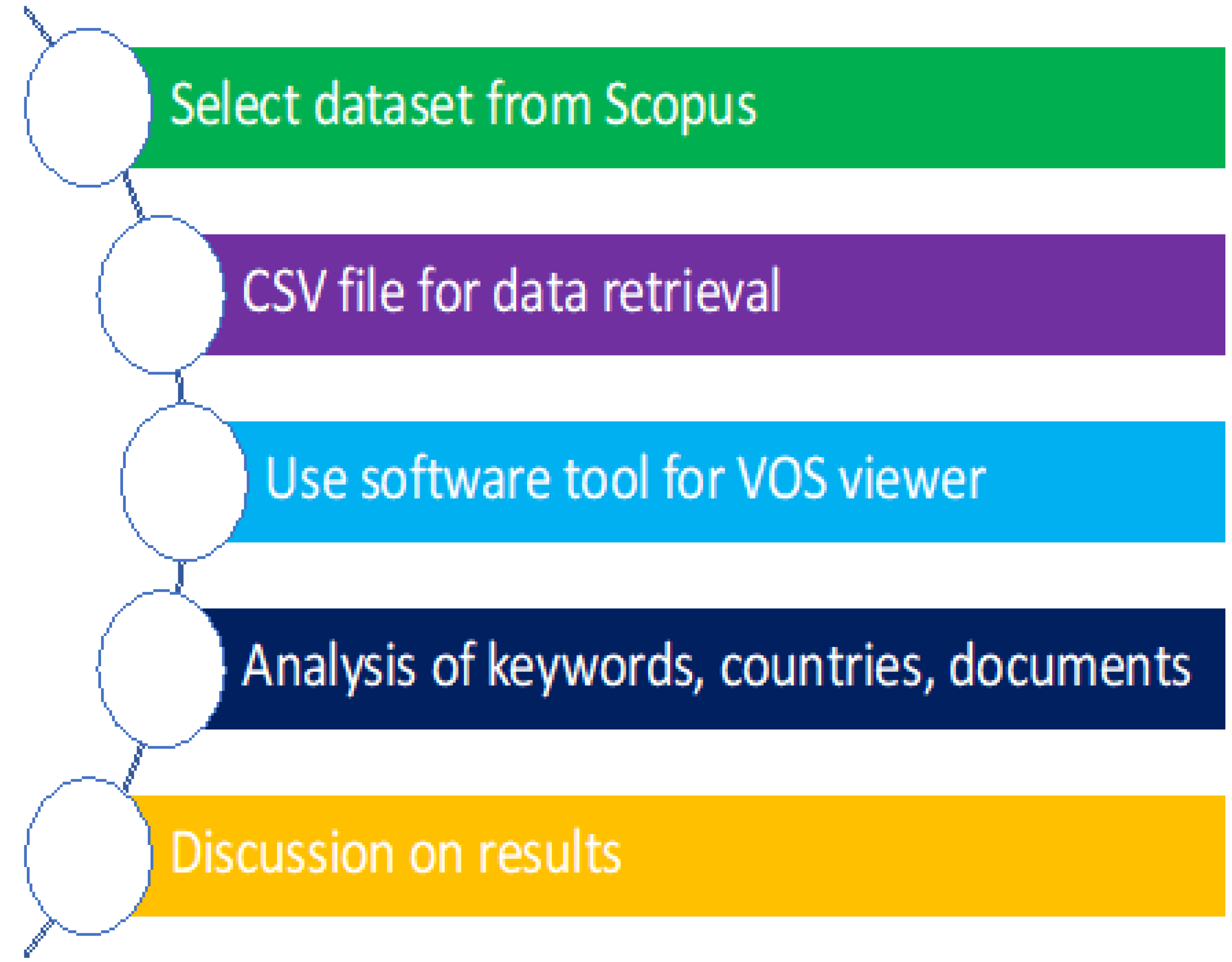
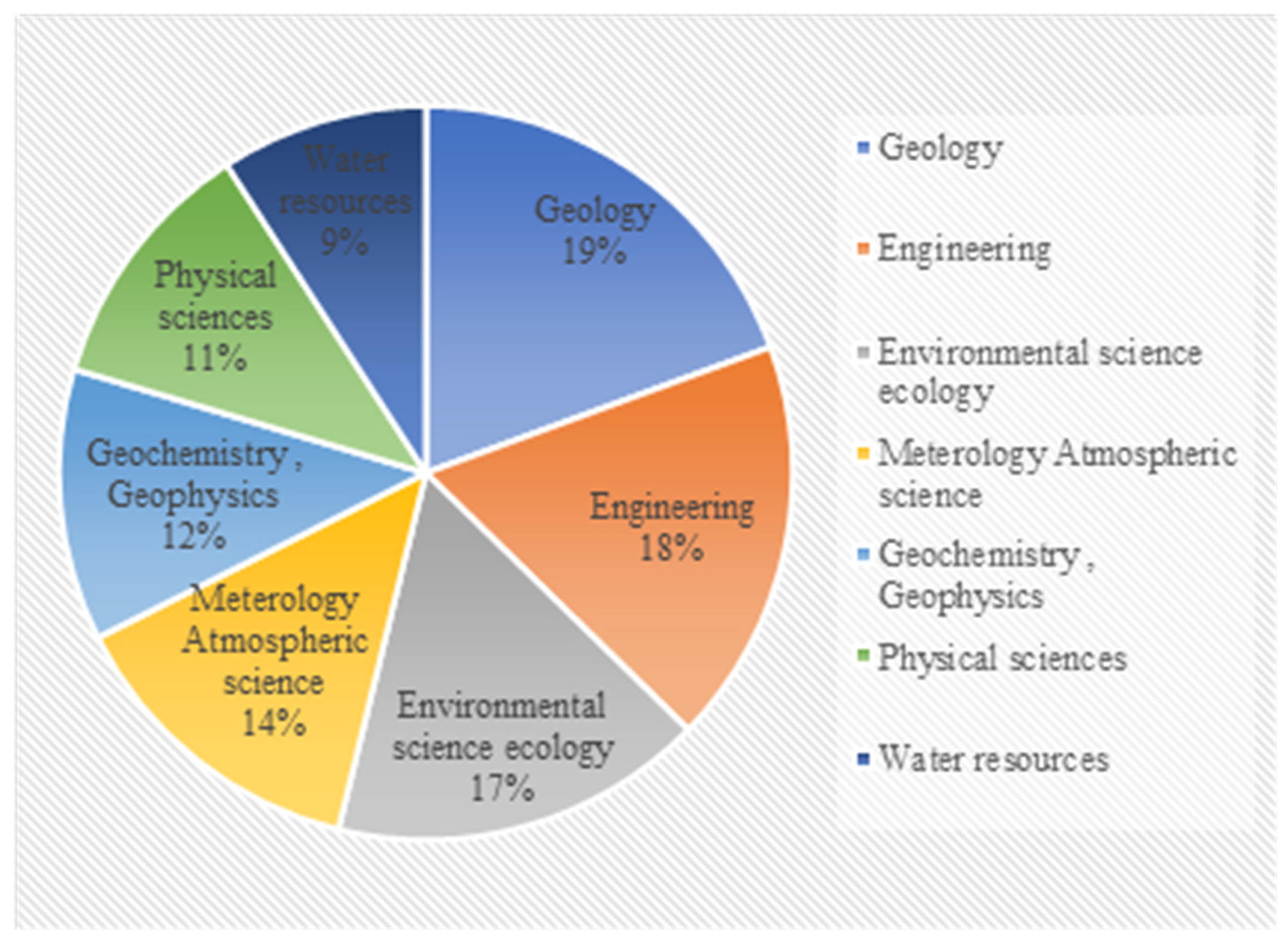

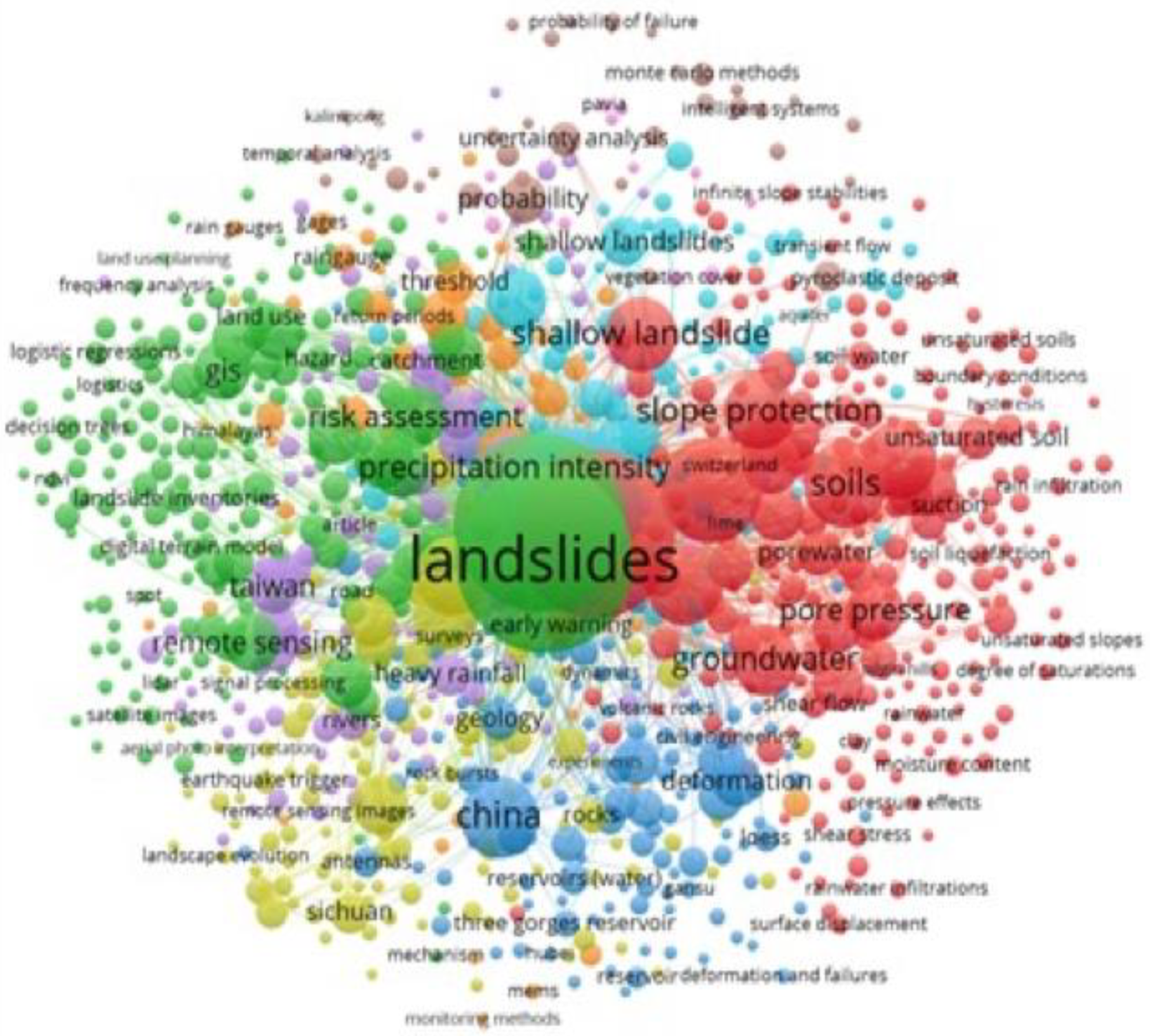
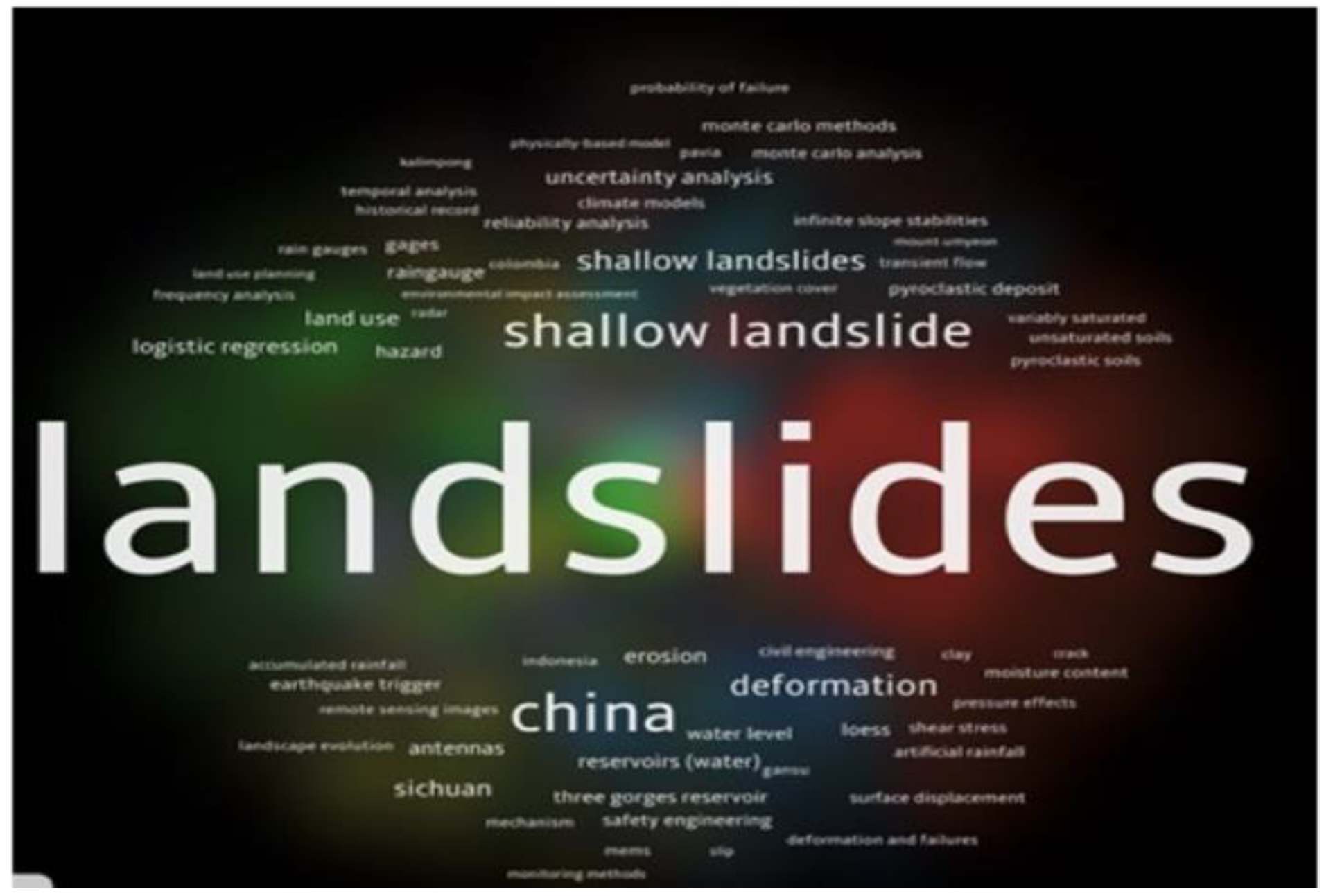

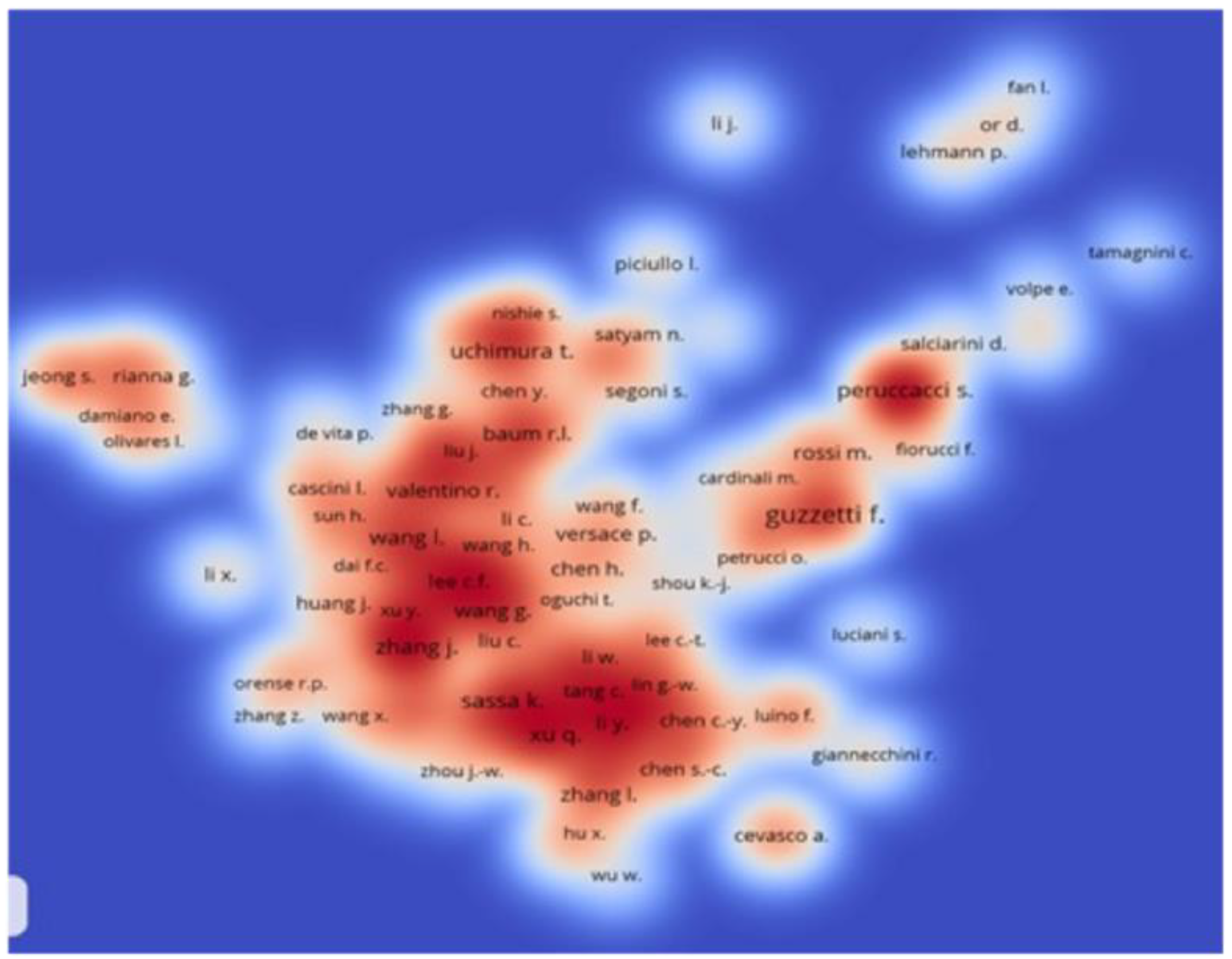


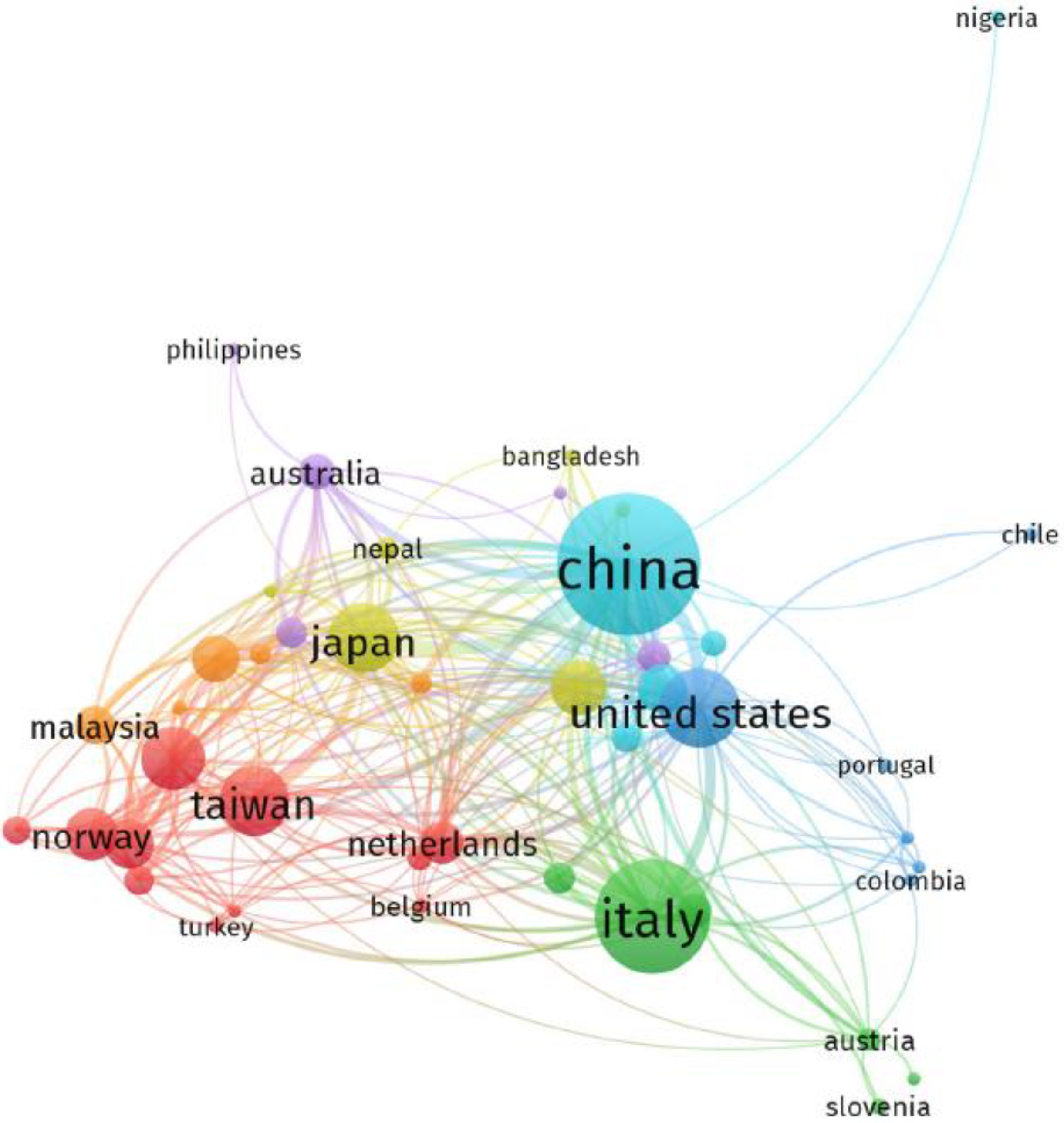




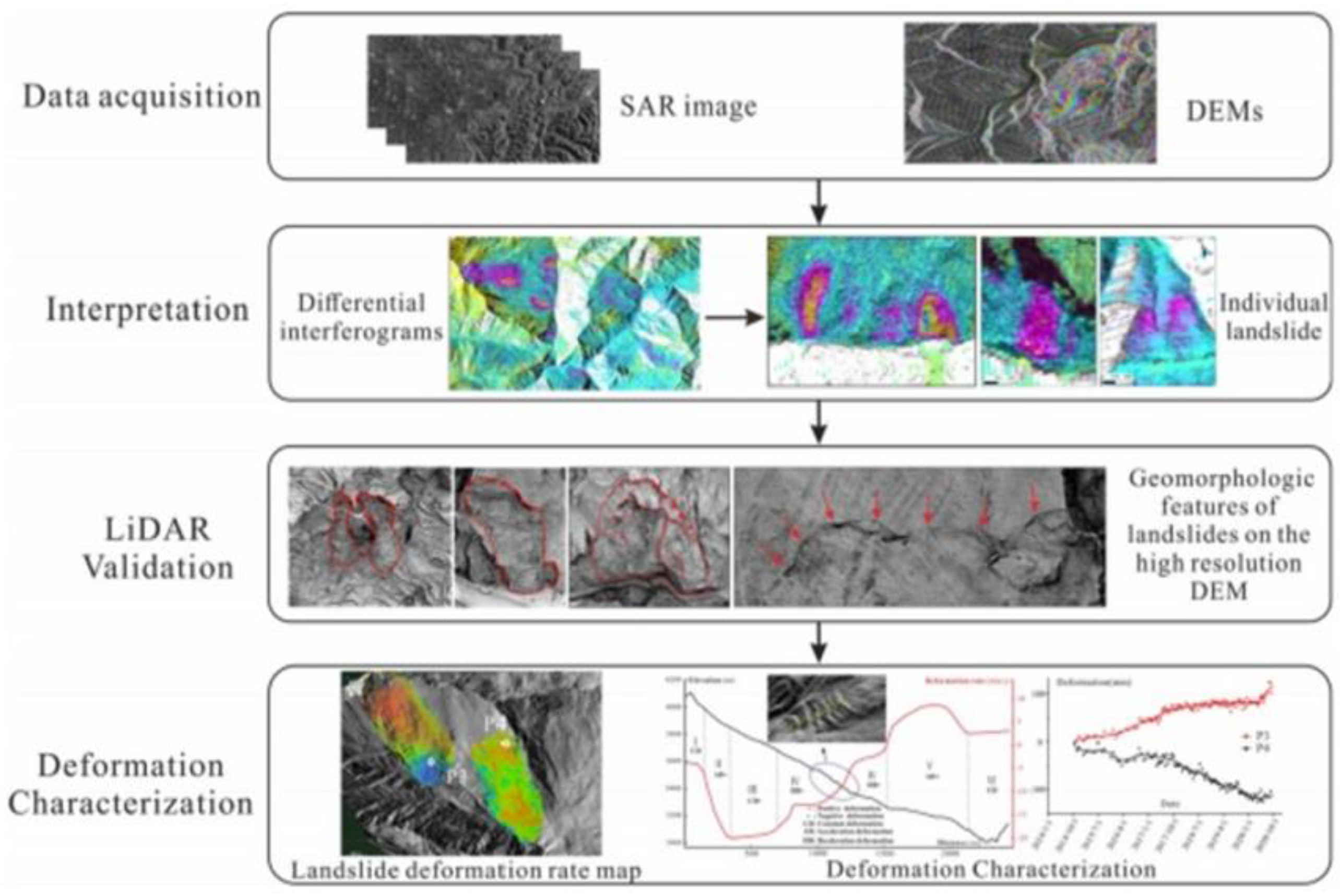


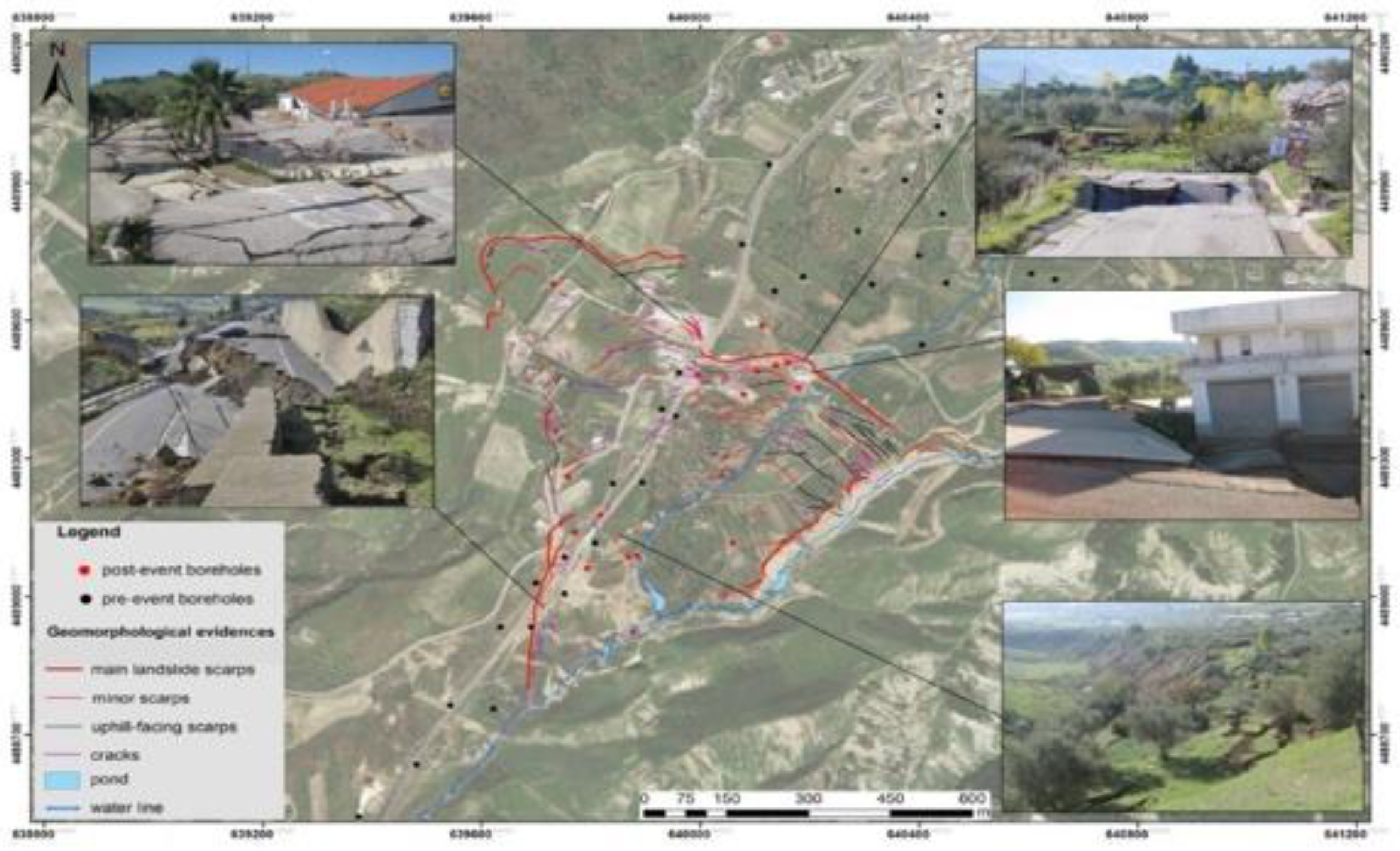


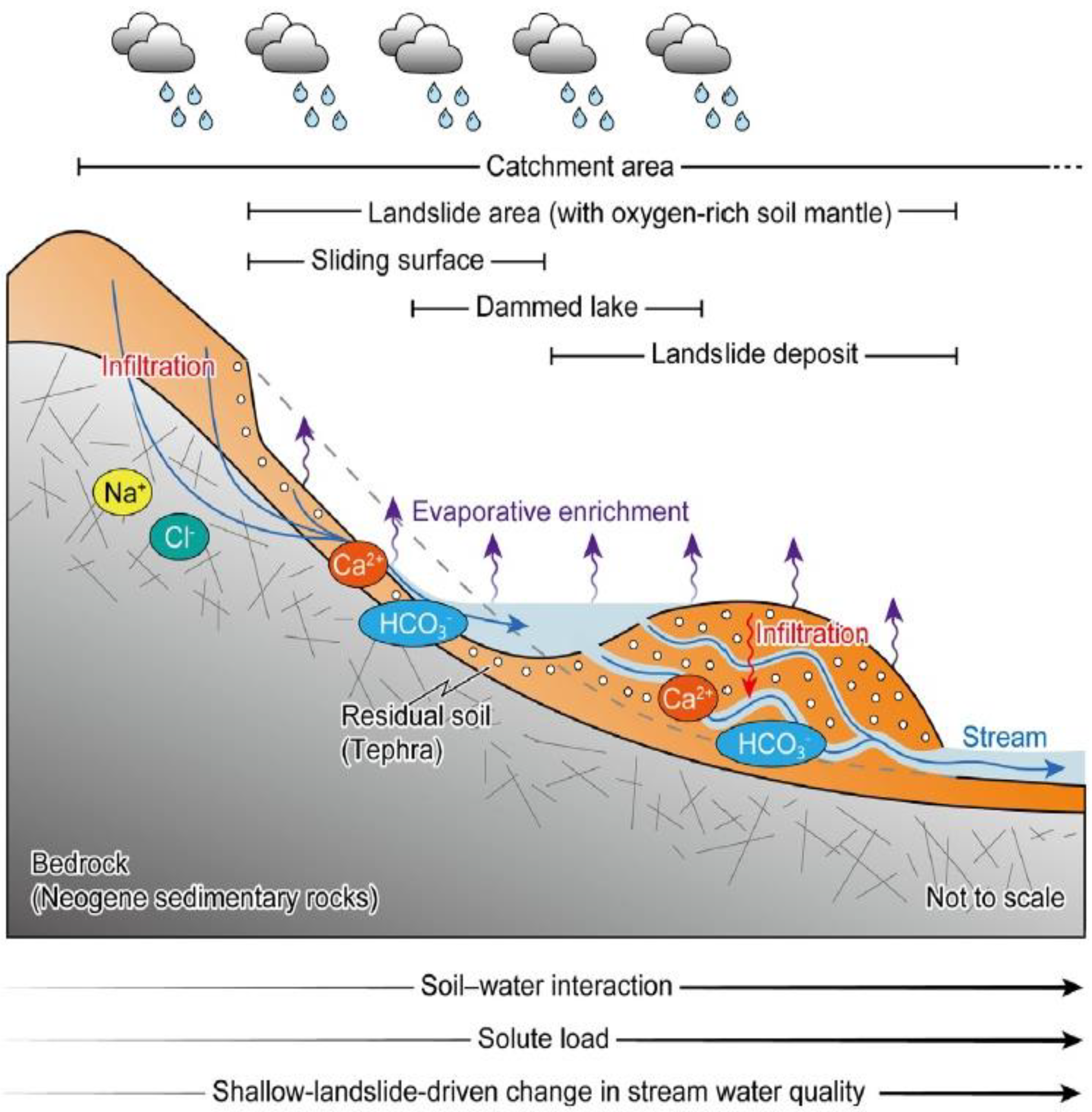
| Keyword | Occurrences | Total Link Strength |
|---|---|---|
| Landslides | 1078 | 2258 |
| Rainfall | 682 | 1311 |
| Slope stability | 344 | 1264 |
| Soils | 320 | 979 |
| China | 211 | 649 |
| Infiltration | 190 | 630 |
| Slope failure | 203 | 631 |
| Slope protection | 176 | 586 |
| Debris flow | 195 | 496 |
| Precipitation intensity | 167 | 450 |
| Shallow landslide | 174 | 435 |
| Groundwater | 154 | 412 |
| Numerical model | 135 | 403 |
| Debris | 145 | 398 |
| Pore pressure | 116 | 396 |
| Italy | 127 | 380 |
| Hazards | 119 | 369 |
| Hazard assessment | 123 | 363 |
| Rainfall infiltration | 110 | 338 |
| Safety factor | 99 | 330 |
| Author | Documents | Citations | Total Link Strength |
|---|---|---|---|
| Guzzetti F. | 36 | 1652 | 231 |
| Sassa K. | 25 | 1026 | 94 |
| Rahardjo H. | 9 | 1019 | 23 |
| Godt J.W. | 17 | 961 | 98 |
| Pradhan B. | 18 | 881 | 166 |
| Baum R.L | 19 | 852 | 113 |
| Tien Bui D. | 10 | 845 | 14 |
| Wang G. | 17 | 821 | 75 |
| Peruccacci S. | 23 | 821 | 297 |
| Brunetti M.T. | 22 | 795 | 294 |
| Lee C.F. | 10 | 781 | 16 |
| Melillo M. | 16 | 749 | 86 |
| Rossi M. | 17 | 737 | 61 |
| Leong E.C. | 5 | 697 | 15 |
| Cardinali M. | 8 | 670 | 34 |
| Gariano S.L | 17 | 665 | 263 |
| Xu Q. | 24 | 646 | 134 |
| Zhang L.M. | 14 | 625 | 74 |
| Country | Documents | Citations | Total Link Strength |
|---|---|---|---|
| China | 471 | 7384 | 750 |
| Italy | 320 | 7777 | 696 |
| Japan | 206 | 4356 | 359 |
| Taiwan | 184 | 3325 | 250 |
| United States | 156 | 3932 | 330 |
| India | 91 | 1323 | 238 |
| South Korea | 71 | 1165 | 183 |
| United Kingdom | 69 | 1971 | 152 |
| Hong Kong | 64 | 2105 | 134 |
| Switzerland | 48 | 870 | 74 |
| Malaysia | 46 | 1301 | 96 |
| Australia | 42 | 565 | 194 |
| Netherlands | 39 | 811 | 98 |
Publisher’s Note: MDPI stays neutral with regard to jurisdictional claims in published maps and institutional affiliations. |
© 2022 by the authors. Licensee MDPI, Basel, Switzerland. This article is an open access article distributed under the terms and conditions of the Creative Commons Attribution (CC BY) license (https://creativecommons.org/licenses/by/4.0/).
Share and Cite
Zou, Y.; Zheng, C. A Scientometric Analysis of Predicting Methods for Identifying the Environmental Risks Caused by Landslides. Appl. Sci. 2022, 12, 4333. https://doi.org/10.3390/app12094333
Zou Y, Zheng C. A Scientometric Analysis of Predicting Methods for Identifying the Environmental Risks Caused by Landslides. Applied Sciences. 2022; 12(9):4333. https://doi.org/10.3390/app12094333
Chicago/Turabian StyleZou, Yong, and Chao Zheng. 2022. "A Scientometric Analysis of Predicting Methods for Identifying the Environmental Risks Caused by Landslides" Applied Sciences 12, no. 9: 4333. https://doi.org/10.3390/app12094333
APA StyleZou, Y., & Zheng, C. (2022). A Scientometric Analysis of Predicting Methods for Identifying the Environmental Risks Caused by Landslides. Applied Sciences, 12(9), 4333. https://doi.org/10.3390/app12094333





